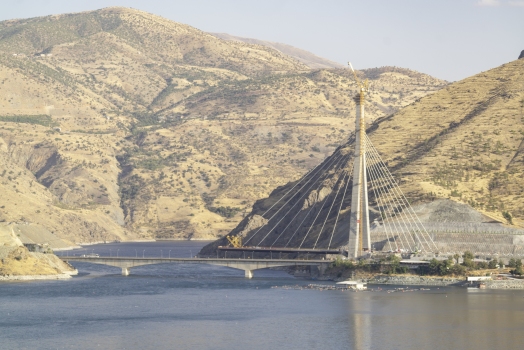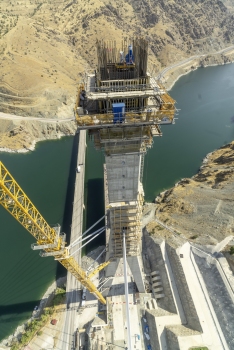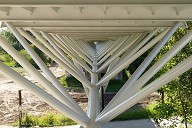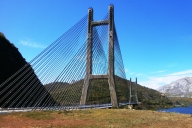Kömürhan Bridge – the world’s fourth longest single pylon cable-stayed bridge
Constructed over the Karakaya Dam Lake, the Kömürhan Bridge will soon forge part of the Malatya-Elazig State highway in Eastern Turkey. Measuring 660 metres in length, the bridge features a cable-stayed design with a single pylon, which stands at 165 m in height. This special type of bridge, which is the fourth single pylon cable-stayed bridge in the world, will also serve an important regional role as a logistics corridor, not only connecting Malatya and Elazığ, but also serving as a strategic crossing for the 16 provinces of Eastern Anatolia. The Kömürhan Bridge is supposed to be completed in July 2020.
Media
Located approximately 700 kilometres east of the Turkish capital of Ankara and 400 kilometres north of the Syrian border lies the province of Malatya, a region famed for its apricots and now the tallest pylon in the country.
‘Y’ shaped concrete tower
Standing at a height of 168.5 metres, the ‘Y’ shaped reinforced concrete tower is the centrepiece of the new Kömürhan Bridge, a suspension structure traversing the Fırat River and the Malatya-Elazığ regional borders. Stretching just over half a kilometre at 660 metres the bridge has an edge opening of 180 metres, a middle opening of 380 metres and a width of 24 metres. The deck cross-section will be orthotropic steel, while the superstructure of the bridge will be connected to the pylon with 42 tensioned cables.
Old bridge will be preserved
In context of the wider project, it is part of a 5,225 metres four-lane highway that includes a 120-metre viaduct and a 2,400 metres tunnel, providing passage to the Karakaya Dam a few kilometres to the south. The existing old bridge and crookedly connected roads will be preserved. The new bridge and the tunnel will be developed next to the existing route.
Working under the joint venture of Doğuş and Gülsan, Doka Turkey was awarded the contract to design and supervise the execution of formwork, which commenced in August 2017. With the bridge scheduled to open in 2020, we spoke with project manager, Mr. Taha Özdilek, who commented on his experience with Doka Turkey.
“Safety was our main priority on this project and Doka has maintained an excellent track record where this is concerned. Most of my team were accustomed with Doka’s products and systems and knew that the solution presented, and the site support received would add much value. Our team was also familiar with Doka’s solution for a similar project (Nissibi Bridge), which was delivered in 2015 and therefore knew they would be well suited for the job.”
Major Challenge: the Pylon's Shape
In terms of the practical formwork solution, the major challenge was focused on the pylon, specifically its shape.
An automatic climbing formwork was used on the mast-shaped pylon head, while a specially adapted double set was used on the two inclined pylon legs with bespoke solutions created at junction points to maintain the highest standards of quality and safety. A large-area formwork was used for the pylon with Doka D2/D3 and Load-bearing Towers Staxo 100 shoring systems for the approaching viaduct. While a tower and mobile crane were used for the pylon and viaduct respectively, the formwork solution was otherwise self-sufficient and delivered its portion of the project safely, on time and on budget.
References
Structure Types
- About this
data sheet - Product-ID
7673 - Published on:
17/06/2020 - Last updated on:
07/12/2020









